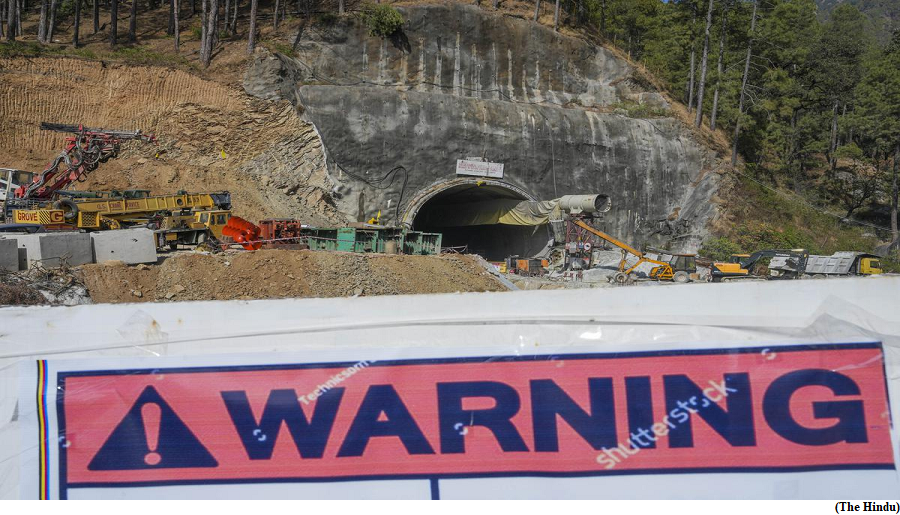Moulding the Himalayas needs caution (GS Paper 3, Environment)

Context:
- As the efforts to evacuate 41 workers trapped in a tunnel near Silkyara in the Uttarkashi district of Uttarakhand are weeks away from fruition, the infrastructure development trajectory in the Himalayas comes under scanner once again.
- The current model of widening roads, rampant construction of hydropower projects, and the unbridled impetus for tourism cannot be called a sustainable way of development.
Char Dham Project:
- The Char Dham Project, all-weather roads, being constructed by the National Highway Authority of India (NHAI) in Uttarakhand, linking the four religious pilgrimages of Gangotri, Yamunotri, Badrinath, and Kedarnath, has brought into focus two major issues in the Indian Himalayan Region (IHR).
- The foremost one is about the development model itself and, in concrete terms, what should be the carrying capacity of the IHR.
- Also important are the processes in which environment clearances were sought, undermining safety protocols, and a new form of architecture that should be built to construct and monitor infrastructure projects, if at all they are desired, in the region.
- The irony is that the flash floods of 2013 in Uttarakhand are suggested as the reason for the construction of the Char Dham Yatra.
Fragile Zone:
- One of the major problems in this project is in accepting the fact that the Himalayas are the youngest range of mountains and still in the formative stages.
- Geological and geotechnical studies make the point clear that this is a dangerous project and fatality-induced.
- The Main Central Thrust of the Himalayas passes a few kilometres north of the incident site, scientists have pointed out in the past as well. This means the area is extremely sensitive to earthquakes and frictional shear rocks are present as well. Constructing in this zone is dangerous.
Undermining EIA assessment:
- Now, the NHAI has said it is going to conduct a detailed inspection of 29 tunnels in the country for further safety and avoiding accidents.
- The haste going about constructions and projects in the region has led to a situation where even the basics of mountain construction codes have been set aside. The Environment Impact Assessment has not been taken seriously.
- Take for example the Char Dham Project, which is around 900 km long and should have a single EIA. However, the project was broken into 53 sections so that the EIA is prepared for a lesser region. The impact exhibited would also be lesser than for a large ecosystem of 900 km.
Carrying capacity in the IHR:
- The Supreme Court of India has already seized on the matter on the issue of carrying capacity in the Himalayas. Now is the time when the apex court should push for a dialogue on it.
- The carrying capacity cannot just be limited to the number of people an ecosystem can sustain; it also has to take into cognisance the total carrying capacity of the IHR from the infrastructure aspect.
- How many hydropower projects can the region sustain? How much tourism? How many roads? How much widening of the roads should be allowed? How much cutting of the mountains and dumping of the debris in the water ecosystem is good?
- The IHR is in a transformative phase and the impetus for this transformation unfortunately comes from the new geographies.
- There are spatial and temporal changes that go beyond the scope and spaces of the Himalayan aesthetic, culture, and building typologies. Sheer integration with the rest is not the way of sustaining them.
Safety protocols:
- In this scenario, there is also an exception and that is in the construction of the Atal tunnel in the Kullu, and Lahaul & Spiti districts of Himachal Pradesh.
- The executing company was so particular in implementing safety measures that not a single casualty has been reported in its construction. They would not allow the workers to enter the tunnel unless all the protocols were followed and checked.
- Likewise, international protocols and monitoring processes should be adopted.
- A new legislative architecture that allows people to monitor these projects and ensures that geological experts are part of every move is required.
- The local communities should be an essential part of these monitoring structures with strict protocols. Likewise, civil society groups and community-driven organisations should be included.
Way Forward:
- As far as the Himalayas are concerned, the NHAI must realise that they are making roads on soil and mountains and not on drawing boards in their offices.
- While they have accepted that they are learning from their failures, this should not have happened in the first place.
- The BRO and even the PMGSY have a better protocol of construction, where a certain period is allowed for stability. Whereas the overemphasis on meeting targets without stability and safety standards is further accentuating the disaster proneness.


